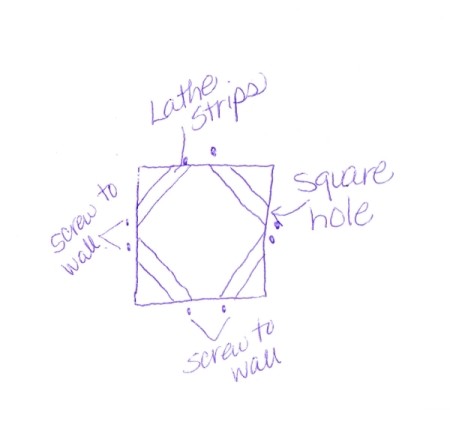
The first thing you need to do is determine if the hole is near electrical wiring. If it is, make sure the power is off to that wall or the whole room. You can use extension cords from the other room for your power tools.
Cut a square just a smidge bigger than the hole. What my crew always did was to have some lathe strips handy. You cut four pieces 1/2 the length of the four sides of the hole. Then, using of deck screws to secure them, you angle each piece of striping in the back of the hole, inside the wall, at an angle.
In other words, you miter them to support the patch piece you are doing. That will mean you have two screws on the wall that secure each lathe piece to the inside. I am no artist, but see the illustration to help visualize this. Now, cut the patch piece the size of the square hole. Make a mark where the strips are on the wall so you know where to use the deck screws.
You are ready to place the piece in the hole, and screw in two (or one if it's a smaller patch) where the patch piece is to adhere to the strips. This will secure the patch and you can fill in the gaps with mud and let dry, sand, prime, and paint. PLEASE do not do what some people do and wad up some news paper and try and patch it so they are not held accountable for the damage. I admit these are generally residents who want to hide stuff, but most of us can tell a bad patch job when we see it and "push" into it.
If the hole is smaller, there are patch screens you can get, but if the hole is 4 inches or larger, this won't work as well and eventually does sink in.
Some Free Advice: After 20 years of property management, I have found there are things anyone can do to prevent holes in walls. Here are my two favorites.
I know that sometimes things aren't done by residents but I hope this helps.
By Sandi/Poor But Proud from Salem, OR

Add your voice! Click below to comment. ThriftyFun is powered by your wisdom!